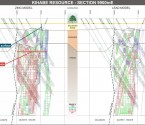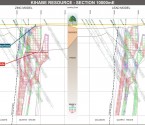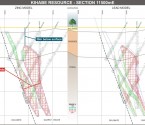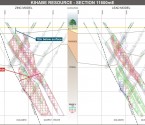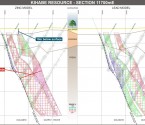Kihabe-Nxuu Zinc/Lead/Silver/Germanium and Vanadium Project - Botswana
Location: West Ngamiland, Botswana
Owner: Mount Burgess Mining NL 100% (MTB)
Project Location
The Kihabe – Nxuu Zinc/Lead/Silver/Germanium and Vanadium Project is located in Western Ngamiland, Botswana, on the border with Namibia, about 700km north west of the capital Gaborone. The project is 350km by road from Maun, Botswana.
Prospecting Licence
Prospecting Licence PL 043/2016, an area of 1000 sq km, covers that portion of a Neo-Proterozoic belt of metasedimentary rocks, hosting what is believed to be SEDEX style mineralisation.
Resource Base
To date MTB has developed resources at two deposits. The Kihabe and Nxuu deposits, 7 kms apart, contain indicated and inferred 2004 JORC compliant resources of 25 million tonnes @ 3% Zn/Pb together with 3.3 million ounces of Silver at Kihabe. Both the Kihabe and Nxuu deposits also contain credits of Germanium and Vanadium mineralisation which are not included in the above resource estimate. Depending upon confirmed recoverability, these could add significant further value to the resource base.
RESOURCE STATEMENT FOR THE KIHABE AND NXUU DEPOSITS
|
Deposit |
External Zn-eq Cut % |
Indicated M Tonnes % |
Inferred M Tonnes % |
Total M Tonnes % |
Contained Zinc metal (kt) |
Contained Lead metal (kt) |
|
Kihabe |
1.5% |
11.4 @ 2.90%* |
3.0 @ 2.60%* |
14.4 @ 2.84%* |
259kt |
115kt |
|
Nxuu |
0.3% |
- |
10.9 @ 3.20%* |
10.9 @ 3.20%* |
196kt |
153kt |
|
|
|
11.4 @ 2.90%* |
13.9 @ 3.07%* |
25.3 @ 3.00%* |
455kt |
268kt |
|
*Zinc Equivalent |
Zn |
Pb |
Ag |
|
Kihabe resource calculated on metal prices as at 17/7/2008 |
US$1,810/t |
US$1,955/t |
US$18.75/oz |
|
Kihabe Grades |
Zn 1.8% |
Pb 0.8% |
Ag 7.7g/t |
|
Nxuu resources calculated on zinc and lead par value metal prices |
|
|
|
|
Nxuu Grades |
Zn 1.8% |
Pb 1.4% |
|
This information was prepared and first disclosed under the JORC Code 2004. It has not been updated since to comply with the JORC Code 2012 on the basis that the information has not materially changed since it was last reported.
The information in the resource statement that relates to the Kihabe Resource is compiled by Byron Dumpleton, B.Sc., a member of the Australasian Institute of Geoscientists. The information that relates to the Nxuu Resource is compiled by Mr Ben Mosigi, M.Sc., (Leicester University – UK), B.Sc., (University of New Brunswick – Canada), Diploma Mining Tech (Haileybury School of Mines – Canada), a member of the Geological Society of South Africa.
Mr Dumpleton is an independent qualified person and Mr Mosigi was a Technical Director of the Company during the period in which the resource was calculated. Both Mr Dumpleton and Mr Mosigi have sufficient experience relevant to the style of mineralisation under consideration and to the activity to which they have undertaken to qualify as a Competent Person as defined in the 2004 Edition of the “Australasian Code of Reporting of Exploration Results, Mineral Resources and Ore Reserves”. Both Mr Dumpleton and Mr Mosigi consent to the inclusion in this report of the matters based on the information in the form and context in which it appears.
The in-ground Zn/Pb/Ag metal content of the current resource base consists of some 750,000 tonnes of Zn equivalent metal.
The Kihabe deposit covers a strike length of 2.4 km, with two proposed open-cut pits covering a total strike length of 1.8 km, containing 14.4 million tonnes of resources. Within the 1.8 km of strike, the average width of the deposit is 27m from 5m below surface to 175m depth, the extent of the resource drill depth to date. Many sections of the resource are between 35m to 60m wide. With confirmatory geotechnical drilling, it is estimated that the two proposed Kihabe pits will have strip ratios in the order of 4.5 : 1.
Refer to Kihabe and Nxuu Drill Sections at the bottom of this page.
The Nxuu deposit covers an area of 550m by 250m with a total estimated depth of only 60m, containing 10.9 million tonnes of resources. Whilst further drilling has yet to be conducted to enable a pit to be designed, it is estimated that an open cut on this basin shaped deposit will have a strip ratio in the order of 3 : 1.
With both deposits being shallow (under 5m to 15m Kalahari sand cover) with potential low strip ratios, they represent potential low cost open-cut mining operations.
Style of Mineralisation
Mineralisation at both the Kihabe and Nxuu deposits has been described as being of late stage SEDEX style. Most SEDEX style deposits are found in dolostone. In this region however, later stage mineralisation occurred after quartzite deposits formed over the dolostone through weathering and deposition from regional elevated or mountainous areas. Whilst the mineralisation occurs at the contact with the regional dolostone, it was formed within what at the time was an overlying quartz wacke. With subsequent thrusting, folding and shearing, these deposits now range from being anything from horizontal to vertical as well as being in synclinal or anticlinal fold structures.
Mineralisation at the Kihabe Deposit occurs within an almost vertical synclinal fold structure. Mineralisation at the Nxuu Deposit occurs in a flat lying basin shaped structure.
Oxide/Sulphide Mineralisation
Mineralisation at the Nxuu Deposit is totally oxidised. The top 25% of the Kihabe Deposit is oxidised. The remaining underlying 75% of the Kihabe Deposit contains sulphide mineralisation.
THE NXUU DEPOSIT - All oxide mineralization
Metallurgical test work conducted to date on the Nxuu deposit has shown that Zn metal can be recovered on site through solvent extraction and electrowinning (SX/EW). Tank acid leaching at 25 deg C. (Botswana’s ambient temperature), using 30 kg/t acid, followed by electrowinning, recovers 95% Zn in 12 hours. This process eliminates significant concentrate transport costs as well as smelter costs. On-site beneficiation also allows for the capture of other metal credits.
Lead mineralisation in the Nxuu deposit is found in the Pb carbonate cerussite. Metallurgical test work conducted on the cerussite has shown that recoveries of 93% can be achieved in 12 hours in the form of a Pb compound, which can be transported from site.
THE KIHABE DEPOSIT - Oxide zone
Zinc mineralisation in the oxidised zone of the Kihabe deposit is found in the Zn oxide minerals baileyclore and smithsonite. Metallurgical test work conducted to date on the Kihabe oxide zone has shown that Zn metal can be recovered on site through SX/EW. Tank acid leaching at 40 deg C, using 30Kg/t acid followed by electrowinning, recovers 96.9% Zn in 24 hours. This process eliminates significant concentrate transport costs as well as smelter costs. On-site beneficiation also allows for the capture of other metal credits.
Lead mineralisation in the oxidised zone of the Kihabe deposit occurs predominantly as galena (sulphide) together with minor oxide minerals. Metallurgical test work has shown that 91.9% Pb recoveries are achieved through flotation and concentration. A Pb concentrate will be produced on site for shipment to a smelter.
Acid consumption in the region of 30 kg/t to recover Zn metal on site from both the Nxuu deposit and the Kihabe deposit oxide zones, is considered to be low and economical because the mineralisation occurs in quartz wackes, low in carbonates. Further test work is required to achieve concentration of the oxide minerals smithsonite and bailychlore, prior to acid leaching, in order to reduce tonnages treated and further reducing acid consumption. It is envisaged that a process of heavy media separation can be successfully applied because of the high SG’s of both smithsonite and baileychlore.
THE KIHABE DEPOSIT - Sulphide zone
Zinc mineralisation in the sulphide zone of the Kihabe deposit occurs as sphalerite and lead mineralisation occurs as galena. Metallurgical test work has shown that at a 75 micron grind size, 93.8% Zn recoveries and 88.1% Pb recoveries are achieved within 15 minutes through flotation and concentration. Zn and Pb concentrate can be produced on site for shipment to a smelter.
This same metallurgical test work has also shown that 96.4% of silver (Ag) can also be recovered within 15 minutes. The Company is investigating the process for recovering Ag on site.
OTHER METALS - VANADIUM, GERMANIUM AND COPPER
Both the Nxuu and Kihabe Deposits also contain significant credits of Vanadium and Germanium mineralisation that have not been included in any previous resouorce calculations.
At the Nxuu Deposit recent drilling has defined significant intersections of Vanadium mineralisation of up to 22m true width at 1832 ppm and as shallow as 3m below surface (Kalahari Sand Cover). Mineralisation averaging in excess of 1,000 ppm Vanadium has been defined over an area of some 270m x 100m, with the potential of further extension. Significant intersections of Vanadium mineralisation have also been defined in zones outside the perimeters of the Zn/Pb mineralisation,with the probability of expanding the current resource area.

Sustainability of the recent increase in the Vanadium price adds significantly to the in-ground values of both the Nxuu and Kihabe Deposits.
Whilst metallurgical test work has yet to be conducted to determine the recoverability of Vanadium, mineralogical test work conducted to date has shown that Vanadium mineralisation at Nxuu and Kihabe is hosted within Vanadinite/Descloizite. At Berg Aukas and Abenab mines in Namibia, situated in the same Neoproterozoic belt as Nxuu and Kihabe, Vanadinite/Descloizite was recovered effectively through the simple and inexpensive process of wet table gravity separation.
Testwork is also required to determine the recoverability of Germanium.
REGIONAL VANADIUM DEPOSITS
Drilling at other Zn/Pb regional targets on PL 43/2016 has also returned intersections of Vanadium mineralisation. These are at :
- the Gossan Anomaly - 8 km south of the Kihabe Deposit (Refer to ASX announcement 26 June 2018)
- the Wanchu West Anomaly - 1 km SW of the Kihabe Deposit (Refer ASX announcement 3 April 2018)
- the Kihabe North Anomaly - 1 km north of the Kihabe Deposit (Refer ASX announcement 3 April 2018)
Ore Process Route (Simplified) - Zinc and Lead only
Provision for Oxidised and Sulphide Ore

Potential to Increase Resources
Potential to increase the Kihabe resource beyond the current 175m depth is very high as drilling to date has intersected wide mineralised zones around the depth of 175m. As a synclinal structure, this further supports the potential for finding deeper mineralisation and the repeat of other parallel mineralised zones.
Potential to increase the Kihabe resource grade by delineating a resource based entirely on diamond core (DD) drilling is high. To date the Kihabe resource base has been delineated based on 112 reverse circulation (RC) drill holes and 32 diamond drill (DD) holes. A comparison of grades from DD holes that were drilled to twin RC holes has shown an increment in grade in the region of 40%. A further exercise was conducted by calculating the average DD grades from only the DD drilling conducted within the 0.5% low-cut resource envelope and comparing them with those grades from ALL drilling, RC and DD, conducted within the 0.5% low cut resource envelope. A similar 40% increment was arrived at. The cost of conducting sufficient DD drilling within the Kihabe resource in order to delineate a resource based entirely on this drilling method will be in the region of US$2 million.
Potential to increase the project's resource base on a regional basis is high. Within this portion of this Neo-Proterozoic belt, considered to host SEDEX style mineralisation, most of which is covered by Kalahari sands of some 5m to 30m depth, there will likely be further quartz wackes which host mineralisation in this region. Since the delineation of the Kihabe and Nxuu resources, Six new quartz wackes have been discovered through drilling, one of which shows elevated Cu mineralisation and five of which show elevated Zn/Pb mineralisation. Further soil geochemical sampling is currently being conducted on these discoveries in order to search for the higher grade zones, which will hopefully reflect the point of contact with the regional dolomite, the zone which, in this region, has previously proven to be of likely commercial grade.
 (click image for Zinc Anomalies)
(click image for Zinc Anomalies)




